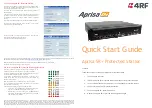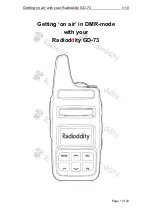
Final Radio assembly:
1. Place
L1
(inductor) to the rear of the board as shown in the pictorial diagram and fasten with thumbtacks or
wood screws. Connect a wire from each tap on
L1
to a paper clip on the board as shown in the pictorial.
2. Layout the paperclips for the antenna connection, ground connection and earphone as shown in the pictorial
diagram. Use wood screws to attach them to the board but do not completely tighten.
3. Connect the wire from the ground (“
B
”) end of
L1
to the paperclip for the ground connection. Connect a
length of hookup from the ground clip to the left earphone paperclip as shown. Tighten the screw for the
ground clip.
4. Fasten the can end of
C1
(tuning capacitor) to the front right corner of the board with a screw through the
bottom of the can. Before the screw is tightened, connect a 6” length of hook-up wire to the can end of
C1
.
Connect the other end of this wire to left earphone paperclip as shown. Tighten the screw for left earphone
clip.
5. Connect the wire from the foil of the
C1
to end “
A
” of
L1
.
6. Connect the glass end of
D1
(diode) to second tap from the “
A
” of the coil and connect the end with the
colored band to the right earphone paperclip. Tighten the screw for the right earphone clip.
7. Fasten the can end of
C2
(antenna coupling capacitor) to the front left corner of the board with a screw
through the bottom of the can. Before the screw is tightened, connect a 6” length of hook-up wire to the can
end of
C2
. Connect the other end of this wire to antenna paperclip and tighten the screw for the antenna
clip.
8. Attach the foil end of
C2
to the antenna clip to first paperclip from the ground end of
L1
.
Operation:
1. Connect a 100’ wire (or as long as you can get) to the antenna clip and connect a wire from a ground rod
to the ground clip on the radio. If a ground rod is not available lay 50’to 100’ of wire on the ground as a
substitute for the ground rod.
2. Connect the earpiece the earphone clips and listen.
3. You should immediately hear a station, or perhaps two stations at the same time.
4. Slide the foil side of C1 up and down to tune in one station at a time.
5. Experiment with different adjustments of the diode tap, antenna tap and tuning capacitor tap to receive
different stations.
The function of the antenna tap on the coil is to provide for the maximum transfer of energy from the antenna to the
tuning circuit. The function of the detector tap is to provide a maximum transfer of energy from the tuning circuit
to the detector. The function of the antenna coupling capacitor is to regulate the amount of energy from the antenna
to the tuning circuit. If the crystal radio is operated near a powerful station, adjustments of the taps can reduce the
amount of energy from the nearby station so distant stations (DX) can be received.
Trouble shooting
- if the radio does not work:
1. Check for wiring errors.
2. Check for complete removal of insulation on the wire at connection points, this is especially important
with enamel-coated wire. An ohm meter or continuity meter is very helpful for this task.
3. Check the connections; make sure they are secure.


























